STEAM Studio AstroTech Unit Focuses on Telescopes Courtesy of Astronomy’s Wong
February 27, 2019
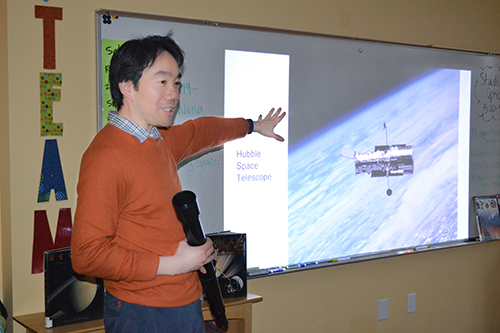
Astronomy Professor Tony Wong introduces STEAM studio youngsters to telescopes.
When folks at STEAM Studio, Next Generation School's after-school program that emphasizes STEAM (Science, Technology, Engineering, and Math [STEM], plus Art) were planning a curriculum on Astro-Technology, they recalled that the father of one of their students was an astronomer. So it made perfect sense for Illinois Astronomy Professor, Tony Wong, to come and present to Kristi Hiatt’s Tera class (3rd–5th graders). During his visit, Wong didn’t get to share much about his research in molecular clouds, star formation, or the evolution of galaxies, but he did get to zero in on a tool he uses on a pretty regular basis: the telescope. And not only did the students learn about different kinds of telescopes and what they’re good for, they actually got to put together some Galileo telescopes and look through them to see what they could see.
According to STEAM Studio Director Angela Nelson, their intent behind the unit was to broaden students’ perspective of what astronomy is:
“When you say space,” Nelson states, “kids think planets, rockets, Mars rovers. So we wanted to break that thought process and start to make them realize all these other opportunities.”
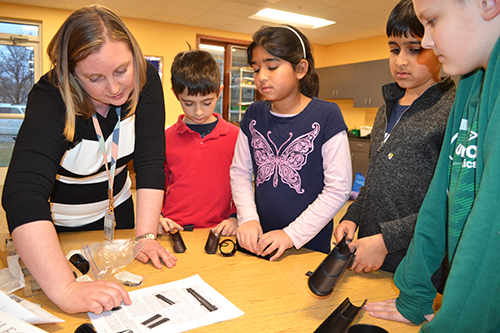
STEAM studio Director Angela Nelson (left) and several students prepare to assemble their Galileo telescope.
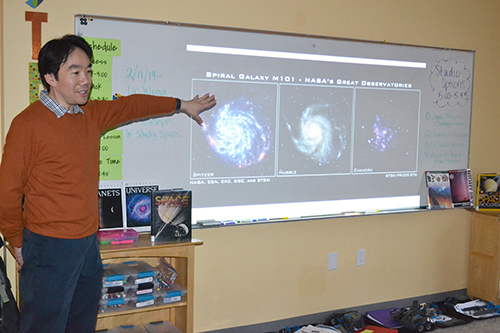
Above: Wong shows the students the view from three of NASA's most famous telescopes: the Spitzer, the Hubble, and the Chandra.
Below: Wong shows the students an app on his phone that is detecting the students' infrared heat signatures.

For instance, Nelson recalls that when planning the unit, they wanted someone with an expertise in astronomy who could help kids understand a little bit more about astro-technology than just rockets. So when they contacted Wong, and his response was, "No, no, I'm not going to be very helpful for you, because I don't work with rockets," their response was, ‘No, no, no. There's so much more to technology. I'm sure that as an astronomer, you gotta’ be doing something with technology. You gotta’ know about stars somehow! You've got to be using computers or satellites; any of that counts as technology.’ So we want to show them the wide range,” Nelson explains.
When, after further discussion, Wong shared how important telescopes are in his research on solar systems, it was decided that he should do a lesson on one very important instrument when it comes to astro-technology—the telescope.
During the activity, Wong described how telescopes work, plus gave them examples of some important telescopes and what they're used for, such as the Hubble Space Telescope, the Chandra X-ray Telescope, and the Spitzer Space Telescope, which focuses on the ultrared band and represents heat. When explaining that the Spitzer could detect infrared heat signatures, he whipped out his phone, on which he had installed an app in order to demonstrate how the telescope worked. The app used the phone's camera to make the invisible infrared light visible and showed the students their heat signatures, which, of course, fascinated the kids who got a kick out of looking at not just their own but each others' heat signatures.
The pièce de résistance of Wong’s lesson, of course, was that he was able to obtain a half dozen Galileo telescope kits that the teams of kids got to assemble. He believes that the hands-on activity he did with the students had a positive impact on them, declaring that “Building the telescopes gave the students a feel for how a telescope works.”
Of course, the real fun began once the students had finished assembling their telescopes and took turns looking through them to see if they could see something…such as down the hallway or out the window. “So it's small, right?” Nelson admits, then philosophizes: “Maybe not the moon, but Galileo had to start somewhere too!"
Wong, who has no doubt spent a great deal of time gazing at the heavens, was a bit disappointed about the viewing material, but is hopeful that should there be a next time, he might get to show the kids some of the cool stuff he gets to see in his work. “Unfortunately, they did not have a chance to use them on a clear night,” he laments, “but for older kids, we would certainly want to do some night observing.”
Regarding the benefit of having university folk visit STEAM Studio in order to interact with elementary school kids, Wong believes that “all kids are interested and curious about science, and so they enjoy meeting people that have made science their career.” He adds that for university researchers like himself, it’s a chance to “share our excitement about science,” divulging that, luckily, he and his colleagues often have flexible schedules that allow them to be out of the office during the day.
Wong believes that, as an expert in his field, one of his responsibilities is not just to answer questions, but to help to correct misconceptions. “When it comes to astronomy,” he explains, “kids automatically will pick up things, but not everything they hear is true.” (Such as from movies or tv, for instance? Exactly how accurate is the astronomy behind, say, Guardians of the Galaxy or Star Trek?!)
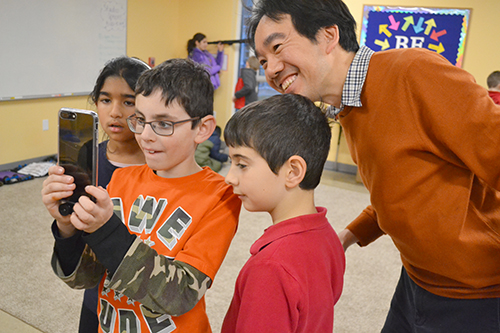
Wong (right) and several students enjoy seeing their infrared heat signatures on his phone.
In addition to introducing the youth to telescopes, Nelson and her team also wanted to give their students a taste of other space-related components. For example, another piece of the curriculum involves students using VEX Robotics to make their own moon rovers that are able to collect rock samples. Their rovers will have five minutes to try and get as many samples as possible as they move through a course, climbing over hills and around or through the valleys while traversing the landscape.
Another astro-tech activity addressed LiDAR (Light Detection and Ranging) which, according to Nelson, is used to map the surface of planets from a remote satellite. To simulate this technology, the Tera students created their own unknown surface using Lego Bricks and placed it inside a shoe box. Then, they created a grid on top of their box so they could use coordinates to map locations. Finally, they used a ruler to mark centimeters on a straw. When they put the straw in the hole on the grid it touched the unknown surface inside the shoe box in order to determine the height of the terrain at that location. Once they collected their data for the unknown terrain they were able to draw a sketch of what the surface looks like.
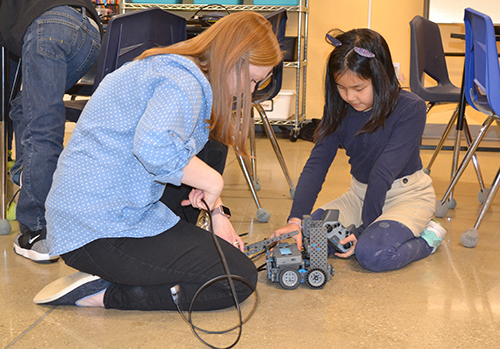
Teacher Kristi Hiatt helps a student trouble shoot her team's Mars rover.
Students also created a device in order to drop off materials at a specific endpoint on the moon. So they actually created some type of zip line system which had to release at a specific point on the zip line. So the students had to figure out a way to stop it and have it drop something.
“It was impressive,” Nelson reports, “some of these systems that these kids had. Some of them worked. Some of them were a little more challenged by it.”
She indicates that through that particular lesson, the kids learned a lot about engineering in terms of iterations and prototypes. In regards to things they would want to change were they to do another iteration after testing, she says some “knew where they would go if they continued, too, saying to themselves, ‘This part of the system is working perfectly; we just need to go further and have a way for it to drop out or a way for it to go faster down the line to actually hit the target that we want.’” She reports that students also learned a lot from watching their peers. Some picked up some things by watching what other the kids had been able to figure out, saying to themselves, “Oh, this is the piece I was missing. We didn't get the tipping point quite right."
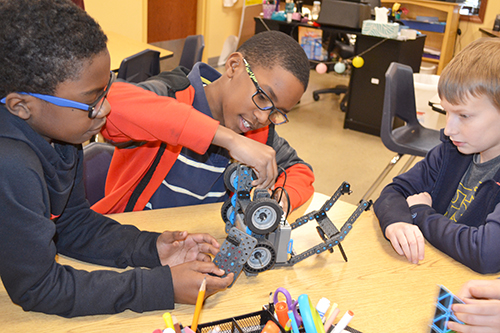
A STEAM Studio student works on assembling his team's Mars rover.
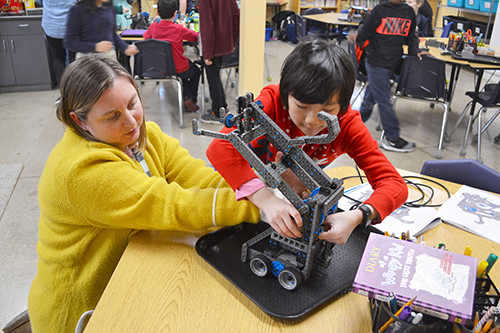
Angela Nelson helps a STEAM Studio student trouble shoot her team's Mars rover.
Another aspect of the astro-tech unit the planners sought to convey was that it’s not just astronomers who look at space, but that it’s a multidisciplinary effort. Nelson says they hoped to refute the notion that only astronomers look at planets, or that if you want to be involved with space, you must become an astronomer or an astronaut. “We want them to start to realize how many different fields are out there, and how you can be involved in this without being an astronomer.” She indicates that in addition to disciplines one might expect to be involved with space, like astronomers and astro-physicists, other completely unexpected disciplines might be involved with space.
For instance, in line with the STEAM emphasis of their program, she suggests that artists consider the heavens too, sometimes in collaboration with scientists who study space.
“Right down to, we're working on art projects of how do you decide what colors the planets are in other solar systems? There's beautiful artwork out there, but do we really know exactly what color those are? So how does an artist make that decision, and how do they work with scientists to come up with something that would be a fair representation for a planet?”
Another key skill they’re trying encourage in their students through this unit is how to problem solve: “How there are multiple solutions to the same component or system that's put in front of you,” Nelson explains. “And that's a big part of what NASA does, right? It's like, we have this problem; we're out in space; we need this fixed. Who can come up with a solution that works with the materials that we have?”
She particularly stresses giving students opportunities to problem solve:
“Because a lot of the jobs and the problems they're gonna’ have to solve in their future, they don't exist right now. So the more we can give them the practice of these situations, and give them a chance to test it out and go, "Oh, I know something about cameras," or "I know something about color," could we take that, with what we know now about the solar system, and build something from it?
Story and photographs by: Elizabeth Innes, Communications Specialist, I-STEM Education Initiative
More: K-6 Outreach, Next Generation School, STEAM Studio, 2019
For more I-STEM articles about STEAM Studio and Next Generation School, please see the following:
- Van der Veen Team Teaches STEAM Studio Students Why Air Pressure Variations and Vacuums Warrant Wacky Weather
- STEAM Studio Uses Science, Technology, and Art to Go “Virtually Spelunking” in Caves—Exploring Everything From Spiders to Bats to 3D Cave Painting to GPS
- Wai-Tat Fu's Lab Partners with STEAM Studio To Make STEM, Spatial Reasoning Fun
- STEAM STudio's STEAMcation Students Visit RailTEC...Learn All About Trains
- Illinois' MCBees Expose STEAM Studio's STEAMcation Students to Medieval Science
- Next Gen's STEAM Studio: An After-School STEM Program With a Dab of Creativity

STEAM Studio teacher Kristi Hiatt helps a student adjust her telescope.
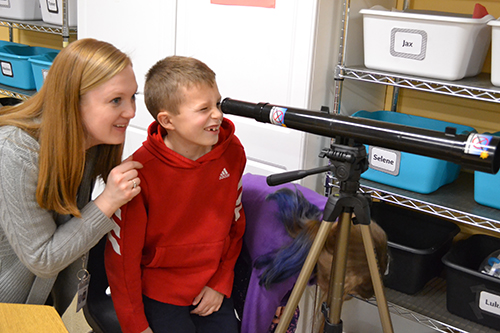
Hiatt and one of her students enjoy looking through the telescope at things outside.
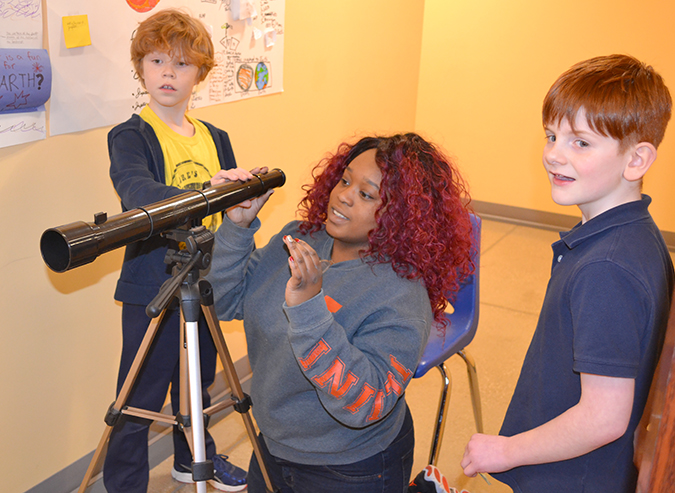
Teaching assistant Deborah Waters (center), who was helping with the activity, prepares to look through the telescope she and several students assembled.